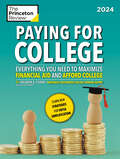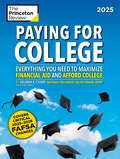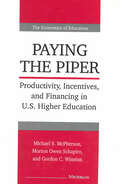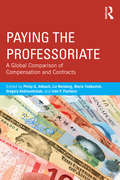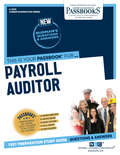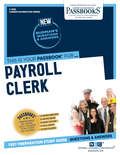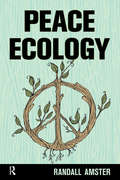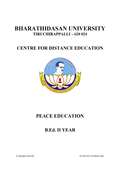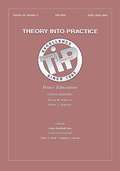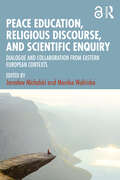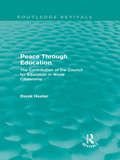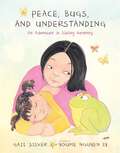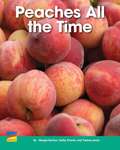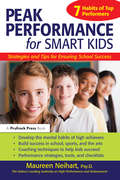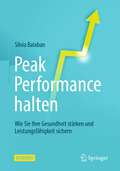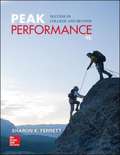- Table View
- List View
Paying for College, 2024: Everything You Need to Maximize Financial Aid and Afford College (College Admissions Guides)
by The Princeton Review Kalman Chany Geoffrey MartzA SMARTER WAY TO PAY FOR COLLEGE. Take control of your financial aid experience with this essential guide—the only annual guidebook with line-by-line instructions for completing the FAFSA aid forms!Financing a college education is a daunting task no matter your circumstances. With line-by-line instructions for filling out the FAFSA and consumer-friendly advice to minimize college costs, Paying for College helps you take control of your experience and:• Maximize your financial aid eligibility• Start preparing now for upcoming changes affecting student aid• Explore long- and short-term strategies to reduce college costs and avoid expensive mistakes• Complete every question on the FAFSA and CSS Profile aid applications to your best advantage• Compare aid offers and learn how to appeal them if necessary • Plan strategically as a separated/divorced parent, blended family, or independent student&“A first-rate guide through the financial aid maze.&” —Lynn Brenner, Newsday&“Can save thousands in college bills.&” —John Wasik, Forbes
Paying for College, 2025: Everything You Need to Maximize Financial Aid and Afford College (College Admissions Guides)
by The Princeton Review Kalman Chany Geoffrey MartzA SMARTER WAY TO PAY FOR COLLEGE. Take control of your financial aid experience with this essential guide—the only annual guidebook with line-by-line instructions for completing the FAFSA aid forms!Financing a college education is a daunting task no matter your circumstances--and with the latest changes to the FAFSA and its rocky rollout, it's never been more intimidating. With line-by-line instructions for filling out the FAFSA and consumer-friendly advice to minimize college costs, Paying for College helps you take control of your experience and:• Maximize your financial aid eligibility• Explore long- and short-term strategies to reduce college costs and avoid expensive mistakes• Complete every question on the FAFSA and CSS Profile aid applications to your best advantage• Compare aid offers and learn how to appeal them if necessary Get advice for handling the impact of the 2024–2025 &“FAFSA Fiasco&” &“A first-rate guide through the financial aid maze.&” —Lynn Brenner, Newsday&“Can save thousands in college bills.&” —John Wasik, Forbes
Paying for the Party
by Elizabeth A. Armstrong Laura T. HamiltonTwo young women, dormitory mates, embark on their education at a big state university. Five years later, one is earning a good salary at a prestigious accounting firm. With no loans to repay, she lives in a fashionable apartment with her fiancé. The other woman, saddled with burdensome debt and a low GPA, is still struggling to finish her degree in tourism. In an era of skyrocketing tuition and mounting concern over whether college is “worth it,” Paying for the Party is an indispensable contribution to the dialogue assessing the state of American higher education. A powerful exposé of unmet obligations and misplaced priorities, it explains in vivid detail why so many leave college with so little to show for it. Drawing on findings from a five-year interview study, Elizabeth Armstrong and Laura Hamilton bring us to the campus of “MU,” a flagship Midwestern public university, where we follow a group of women drawn into a culture of status seeking and sororities. Mapping different pathways available to MU students, the authors demonstrate that the most well-resourced and seductive route is a “party pathway” anchored in the Greek system and facilitated by the administration. This pathway exerts influence over the academic and social experiences of all students, and while it benefits the affluent and well-connected, Armstrong and Hamilton make clear how it seriously disadvantages the majority. Eye-opening and provocative, Paying for the Party reveals how outcomes can differ so dramatically for those whom universities enroll.
Paying the Piper: Productivity, Incentives, and Financing in U.S. Higher Education
by Michael S. McPherson Morton Owen Schapiro Gordon C. WinstonRising tuitions and shrinking government budgets have pushed questions about productivity and resource use in U.S. higher education to the fore. In Paying the Piper three distinguished researchers examine the many successes of U.S. higher education, identify real problems, and carefully analyze potential solutions. Among the questions addressed are: On what do colleges and universities spend their money and how have their spending patterns changed over time; what does "quality" really mean in higher education and how is it related to price and cost; what are appropriate measures of "productivity"; and does increasing the amount of federal financial aid encourage colleges to raise their tuitions? The essays comprising this volume demonstrate that the application of basic economic principles and a combination of both descriptive and econometric analyses can illuminate a number of issues. Using economic concepts and tools to provide insight into these pressing questions, Paying the Piper helps us to understand the recent past, anticipate the future, and develop policies that can influence the future.
Paying the Price: College Costs, Financial Aid, and the Betrayal of the American Dream
by Sara Goldrick-RabIf you are a young person, and you work hard enough, you can get a college degree and set yourself on the path to a good life, right? Not necessarily, says Sara Goldrick-Rab, and with Paying the Price, she shows in damning detail exactly why. Quite simply, college is far too expensive for many people today, and the confusing mix of federal, state, institutional, and private financial aid leaves countless students without the resources they need to pay for it. Drawing on an unprecedented study of 3,000 young adults who entered public colleges and universities in Wisconsin in 2008 with the support of federal aid and Pell Grants, Goldrick-Rab reveals the devastating effect of these shortfalls. Half the students in the study left college without a degree, while less than 20 percent finished within five years. The cause of their problems, time and again, was lack of money. Unable to afford tuition, books, and living expenses, they worked too many hours at outside jobs, dropped classes, took time off to save money, and even went without adequate food or housing. In many heartbreaking cases, they simply left school--not with a degree, but with crippling debt. Goldrick-Rab combines that shocking data with devastating stories of six individual students, whose struggles make clear the horrifying human and financial costs of our convoluted financial aid policies. America can fix this problem. In the final section of the book, Goldrick-Rab offers a range of possible solutions, from technical improvements to the financial aid application process, to a bold, public sector-focused "first degree free" program. What's not an option, this powerful book shows, is doing nothing, and continuing to crush the college dreams of a generation of young people.
Paying the Professoriate: A Global Comparison of Compensation and Contracts
by Philip G. Altbach Gregory Androushchak Maria Yudkevich Liz Reisberg Ivan F. PachecoHow are professors paid? Can the "best and brightest" be attracted to the academic profession? With universities facing international competition, which countries compensate their academics best, and which ones lag behind? Paying the Professoriate examines these questions and provides key insights and recommendations into the current state of the academic profession worldwide. Paying the Professoriate is the first comparative analysis of global faculty salaries, remuneration, and terms of employment. Offering an in-depth international comparison of academic salaries in twenty-eight countries across public, private, research, and non-research universities, chapter authors shed light on the conditions and expectations that shape the modern academic profession. The top researchers on the academic profession worldwide analyze common themes, trends, and the impact of these matters on academic quality and research productivity. In a world where higher education capacity is a key driver of national innovation and prosperity, and nations seek to fast-track their economic growth through expansion of higher education systems, policy makers and administrators increasingly seek answers about what actions they should be taking. Paying the Professoriate provides a much needed resource, illuminating the key issues and offering recommendations.
Payroll Auditor: Passbooks Study Guide (Career Examination Series)
by National Learning CorporationThe Payroll Auditor Passbook® prepares you for your test by allowing you to take practice exams in the subjects you need to study. It provides hundreds of questions and answers in the areas that will likely be covered on your upcoming exam.
Payroll Clerk: Passbooks Study Guide (Career Examination Series #C-2085)
by National Learning CorporationThe Payroll Clerk Passbook® prepares you for your test by allowing you to take practice exams in the subjects you need to study. It provides hundreds of questions and answers in the areas that will likely be covered on your upcoming exam.
Payroll Supervisor: Passbooks Study Guide (Career Examination Series #C-3154)
by National Learning CorporationThe Payroll Supervisor Passbook® prepares you for your test by allowing you to take practice exams in the subjects you need to study. It provides hundreds of questions and answers in the areas that will likely be covered on your upcoming exam, including but not limited to: fundamentals of account keeping and bookkeeping; supervision; understanding and interpreting tabular material; understanding and interpreting written material; and more.
Peace Ecology
by Randall Amster"Peace Ecology" presents a cutting-edge exploration of an emerging paradigm that links the essence of peace and nonviolence with the tenets of ecology and the principles of environmentalism. Looking at issues including food justice, water sharing, climate change, peace zones, and the free economy, this book considers examples and illustrations from around the world where people, communities, and nations are employing the teachings of ecology as a tool for mitigating conflict and promoting peace. "Peace Ecology" presents an integrative perspective that bears directly upon the most pressing issues of our time, constituting both the ecological realm of peace and the peacemaking potential of ecology. The volume examines the rich history, contemporary relevance, and transformative future potential inherent in this dynamic nexus of theory and action. Its overarching aim is no less than moving the current scarcity-conflict paradigm to one of cooperative resource management and, ultimately, toward peaceful coexistence both among ourselves and within the balance of nature.To read the Common Dreams excerpt of "Peace Ecology" Click Here.Talk Nation Radio Interview with Randall Amster and David Swanson here."
Peace Education
by Dr RajaguruEducation is the key to raise the inner self of the individuals. It is important to inculcate and recognize the crucial role of education in contributing to building a culture of peace.
Peace Education Tip V44#4
by David JohnsonEconomics of the International Financial System offers an illuminating, engaging and lucid account of the working of 21st-century global political economy. From a macroeconomic perspective, it explores how major capitalist economies are closely integrated with each other in that none can remain unaffected by economic events around the globe.The book is one of the first in its genre to examine:the origin and relevance of international money as a concept and phenomenon;the structure of various money markets;the nature and functioning of major international financial institutions such as the World Bank, International Monetary Fund (IMF) and International Bank for Reconstruction and Development (IBRD); andthe dynamics of the new world financial system that emerged after the demise of Bretton Woods system.This will form an essential reading for students and scholars of international monetary economics, international corporate finance, researchers, policymakers, bankers and financial executives.
Peace Education in a Conflict-Affected Society
by Michalinos Zembylas Zembylas, Michalinos and Charalambous, Constadina and Charalambous, Panayiota Constadina Charalambous Panayiota CharalambousPeace education initiatives have been subject to heated public debate and so far the complexities involved have not been fully understood. This multilayered analysis examines how teachers negotiate ideological, pedagogical and emotional challenges in their attempts to enact a peace education policy. Focusing primarily on the case study of conflict-affected Cyprus, Michalinos Zembylas, Constadina Charalambous and Panayiota Charalambous situate the Cypriot case within wider theoretical and methodological debates in the field and explore the implications of their findings for theory and practice. Building on current anthropological approaches, the authors use insights from policy studies and sociolinguistics to examine peace education agendas and the ways these are shaped by the dynamics of local politics and classroom practices. This study will be valuable reading for researchers of peace and policy studies as well as for practitioners and policy makers involved in introducing peace education initiatives that challenge teachers' long-held beliefs.
Peace Education in a Postmodern World: A Special Issue of the Peabody Journal of Education
by Ian M. HarrisThis special issue of the Peabody Journal of Education provides a comprehensive overview of the latest developments in peace education reform. School reforms based upon principles of peace education have in common a belief in the power of peace to create a positive learning climate in schools and to address the problems of violence in the broader culture. A peace education strategy for improving school productivity rests upon three main assumptions: 1. Violence contributes to the poor performance of many students. 2. Adults in school settings need to address problems created by violence in order for schools to improve. 3. Anxieties that make it hard for students to master traditional subject matter can best be addressed by a comprehensive peace education strategy that makes school a safe place to learn and provides students with knowledge about alternative nonviolent ways to resolve conflicts. Peace building reforms go beyond responding to immediate forms of violence that may be overwhelming students and teachers to promoting positive images of peace through the study of nonviolence. Written by established experts in the field of peace education from six different countries, this collection of articles not only represents a wide variety of peace education practices from different corners of the globe, but it also represents varying academic perspectives. Educators can play a key role in helping human societies progress toward more sustainable ways of living by implementing peacemaking, peacekeeping, and peace building strategies in school programs. Peace education reforms point to a new way of thinking about schools as vehicles for promoting a peace culture through insights offered by nonviolent theory.
Peace Education, Religious Discourse, and Scientific Enquiry: Dialogue and Collaboration from Eastern European Contexts
by Jarosław Michalski Monika WolińskaEmpowering educators and policymakers to effect positive change in their communities, this book critically examines how sustained dialogue and cooperation between scientific inquiry and religious discourse can contribute to the fostering of successful peace education initiatives.Providing an overview of the historical and cultural context of peace education in Eastern Europe, the chapters look initially at the theoretical foundations, emphasising the need for empathy, internal peace, and traditional values. Featuring contributions from the United States, Germany, Italy, Slovakia, Turkey, and Poland, subsequent sections outline ethical, moral, and religious dimensions to inform effective peace education strategies, along with a discussion on how they can be harmonised with secular approaches to provide a holistic framework for peace education. Case studies and practical applications follow, ranging from Maria Montessori’s educational approach to the role of social media and sustainability in peace education, providing readers with a comprehensive understanding of how different perspectives can inform effective peace education strategies.With implications and take aways for educators and researchers looking to foster a culture of peace and non-violence, this book will be of interest to scholars, policymakers, postgraduate students, and curriculum designers in the fields of peace education, values education, conflict resolution, and social cohesion more broadly. Those working in peacebuilding organisations and NGOs more widely may also benefit from the chapters.
Peace Is a Four-Letter Word
by Janet Nichols LynchWhen high school student Emily Rankin meets a radical English teacher, the popular cheerleader begins to question her own basic values, the war in Iraq, and the direction her future will take.
Peace Pedagogies in Bosnia and Herzegovina: Theory and Practice in Formal Education
by Larisa Kasumagić-Kafedžić Sara Clarke-HabibiThis collection presents interdisciplinary perspectives on educating for peace in Bosnia and Herzegovina. It explores a range of theories, contexts, pedagogies and practices within formal education settings and draws attention to the multiple roles that teachers play in fostering socially transformative learning. The volume offers readers a critical exploration of peace pedagogy as an imagined ideal and fluid space between post-war educational politics, institutional and curricular constraints, and the lived experiences and identities of teachers and students in socially and historically situated communities. The book highlights local voices, initiatives and practices by illustrating good examples of how classrooms are being connected to communities, teacher education programs and teachers’ continued professional development. It demonstrates why and how the grammars of peace in Bosnia and Herzegovina are still in a state of flux and negotiation, and what the implications are for classroom practice and pedagogy. Recommendations are offered for policymakers, curriculum developers, teacher educators and teachers on how peace pedagogies can be promoted at all levels of the education system and through pre-service and in-service teacher education, taking into account the structural uniqueness of the country.
Peace Through Education: The Contribution of the Council for Education in World Citizenship (Routledge Revivals)
by Derek HeaterFirst published in 1984, Peace Through Education records the history of the first 45 years of the Council for Education in World Citizenship (CEWC). It describes the rise in interest of increased international understanding in the years preceding the book’s publication and highlights the influential role of the CEWC in encouraging educators to make the rising generations aware of threats to world peace. Created in 1939, at a time of tense international crisis, the organization’s record is both an important and fascinating story. The book provides an overview of the history and work of the organization and assesses how far the Council has achieved its objectives, and how successful it has been in satisfying needs and wielding influence.
Peace, Be Still: Messages of Comfort and Hope in Times of Turmoil
by Wayne E. Brickey Terry B. Ball Richard D. Draper Todd B. Parker Richard O. CowanMessages by LDS authors regarding the last days and the Savior's second coming.
Peace, Bugs, and Understanding: An Adventure in Sibling Harmony (Anh's Anger Story)
by Gail Silver Youme Nguy?n LyLily and her little sister Ruby are having a picnic when Ruby spoils their game of checkers. Lily lashes out but soon gets absorbed in a wonderful book, the story of her great grandfather's encounter with a strange looking frog-like creature called Anger. The precious old journal teaches Lily about Metta, a technique that has helped people transform anger into loving kindness for thousands of years.With original watercolors by award-winning illustrator Youme Nguyen Ly, Peace, Bugs, and Understanding is an invaluable tool for parents and teachers, and will help children learn to understand the causes of their own strong emotions, while teaching them peaceful ways to resolve difficulties through mindfulness and meditation. and accepting accountability for their actions when appropriate. By learning these skills, children can grow comfortable with them and carry them into adulthood with ease and confidence.
Peaches All the Time
by Tammy Jones Margie Burton Cathy FrenchIn Peaches All The Time, students learn that peaches need water to grow-but not too much. They also learn about irrigation. Students study how the quantity of peaches available for sale makes a difference in the cost.
Peak Performance for Smart Kids
by Maureen NeihartPeak Performance for Smart Kids provides success strategies, activities, tools, real-life examples, and checklists for parents to employ to help their kids achieve to their highest potential. Even the most talented child will not succeed if he or she has not developed the mental, psychological, and emotional skills to face the heavy demands of high performance. Maureen Neihart, a psychologist and leading authority on talent development in children, examines seven mental habits of successful kids, providing practical approaches for developing them in talented children of all ages in this easy-to-read guide for parents and teachers.By working with parents to complete the activities included in this book, high-ability kids will learn to manage stress and anxiety, set and achieve goals, use mental rehearsal to improve performance, manage their moods and emotions, practice optimistic thinking, and resolve their frustrations of needing to belong while needing to achieve. With its research-based strategies and unique approach to maximizing potential, this is a book from which every parent of smart kids can benefit!
Peak Performance for Smart Kids: Strategies and Tips for Ensuring School Success
by Maureen NeihartPeak Performance for Smart Kids provides success strategies, activities, tools, real-life examples, and checklists for parents to employ to help their kids to achieve their highest potential. Even the most talented child will not succeed if he or she has not developed the mental, psychological, and emotional skills to face the heavy demands of high performance. Maureen Neihart, a psychologist and leading authority on talent development in children, examines seven mental habits of successful kids, providing practical approaches for developing them in talented children of all ages in this easy-to-read guide for parents and teachers.By working with parents to complete the activities included in this book, high-ability kids will learn to manage stress and anxiety, set and achieve goals, use mental rehearsal to improve performance, manage their moods and emotions, practice optimistic thinking, and resolve their frustrations of needing to belong while needing to achieve. With its research-based strategies and unique approach to maximizing potential, this is a book from which every parent of smart kids can benefit!Educational Resource
Peak Performance halten: Wie Sie Ihre Gesundheit stärken und Leistungsfähigkeit sichern
by Silvia BalabanAls Leistungsträger liefern Sie 24/7 mentale Höchstleistung: zunehmende Arbeitsverdichtung, Entscheidungsdauerfeuer und ASAP-isierung gekoppelt mit ständiger Erreichbarkeit und den Folgen von Globalisierung, sowie wirtschaftlichen und politischen Krisen. All das zehrt an Ihrer Energie. All das geht auf Kosten Ihrer Gesundheit. Um ein Auspowern zu vermeiden, ist ein wirkungsvolles, wissenschaftlich fundiertes Trainings- und Regenerationskonzept erforderlich, wie es im Leistungssport seit Jahren Standard ist. Daher bilden neueste Methoden und objektiv messbare Daten aus der Stressmedizin die Basis dieses Buches. Erfahren Sie, wie Sie durch biochemische und biophysische Parameter Ihre Kraft und Regeneration qualitativ verbessern können, denn Fakten schaffen Sicherheit. Praxisnah und leicht verständlich informiert dieser Ratgeber mit Selbstchecks, Fallbeispielen und Praxistipps über die wichtigsten Gesundheitsgrundlagen für berufliche Peak Performance Situationen. Fundiertes Wissen, damit Sie neue Stärke tanken und zukünftige Herausforderungen wieder mit Gelassenheit meistern können.
Peak Performance: Success In College And Beyond
by Sharon K. FerrettThe ninth edition of Peak Performance provides students with common sense strategies for excelling in school and life. From the unique Take 3 feature, which encourages making smart use of even small segments of time, to tips on "How to Say No" to avoid the stress of stretching your time too thin, to "Getting the Most Out of a Class Lecture" that helps students focus during a variety of challenging lecture situations, Peak Performance delivers the essential tools for managing time and resources. Students are provided with ample opportunities to apply and enhance critical thinking skills through Think Fast case studies, in-text questions and activities, and a wide variety of end-of-chapter Worksheets.
